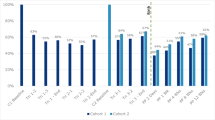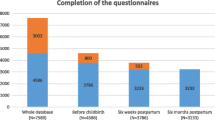Abstract
Our objective was to assess whether postpartum depression risk factors differ between adolescent and adult mothers and to evaluate the need for adolescent specific screening instruments. We performed a retrospective cohort study using data from the Rhode Island Pregnancy Risk Assessment Monitoring System, 2004–2008. We identified maternal age specific risk factors using weighted logistic regression and developed predictive models using a forward selected weighted logistic regression. Notable differences in odds ratios were observed for risk factors such as maternal race (OR Hispanic vs. White: 0.99, 95 % CI 0.49–1.99 among adolescents; 3.32, 95 % CI 2.01–5.49 among adults), pre-pregnancy alcohol use (OR use vs. non-use: 2.04, 95 % CI 1.08–3.86 among adolescents; 0.49, 95 % CI 0.33–0.73 among adults), and pregnancy intention (OR unintended vs. intended: 1.05, 95 % CI 0.37–2.97 among adolescents; 2.67, 95 % CI 1.51–4.74 among adults). In predictive models, adolescent postpartum depressive symptoms were most influenced by prior depression and social support while adult postpartum depressive symptoms were associated with risk factors including maternal race, pregnancy intention, SES, prior depression, mental health during pregnancy, stressors, and social support. We were able to identify similarities and dissimilarities in risk factors for postpartum depressive symptoms among adolescents and adults. Predictive models developed in the general population of pregnant women performed poorly among adolescents relative to age specific predictive models, suggesting that current screening tools may not adequately identify high risk adolescents.

Similar content being viewed by others
References
Reid, V., & Meadows-Oliver, M. (2007). Postpartum depression in adolescent mothers: An integrative review of the literature. Journal of Pediatric Health Care, 21(5), 289–298.
Hudson, D. B., Elek, S. M., & Campbell-Grossman, C. (2000). Depression, self-esteem, loneliness, and social support among adolescent mothers participating in the new parents project. Adolescence, 35(139), 445–453.
Logsdon, M. C., et al. (2005). Postpartum depression and social support in adolescents. Journal of Obstetric, Gynecologic, and Neonatal Nursing, 34(1), 46–54.
Beck, C. T., & Gable, R. K. (2001). Comparative analysis of the performance of the postpartum depression screening scale with two other depression instruments. Nursing Research, 50(4), 242–250.
Georgiopoulos, A. M., et al. (2001). Routine screening for postpartum depression. Journal of Family Practice, 50(2), 117–122.
Passino, A. W., et al. (1993). Personal adjustment during pregnancy and adolescent parenting. Adolescence, 28(109), 97–122.
Oppo, A., et al. (2009). Risk factors for postpartum depression: The role of the postpartum depression predictors inventory-revised (PDPI-R). Results from the perinatal depression-research & screening unit (PNDReScU) study. Archives of Women’s Mental Health, 12(4), 239–249.
Austin, M. P., et al. (2005). Antenatal screening for the prediction of postnatal depression: Validation of a psychosocial pregnancy risk questionnaire. Acta Neurologica Scandinavica, 112(4), 310–317.
Beck, C. T. (2002). Revision of the postpartum depression predictors inventory. Journal of Obstetric, Gynecologic, and Neonatal Nursing, 31(4), 394–402.
Bernazzani, O., et al. (2005). Assessing psychosocial risk in pregnant/postpartum women using the contextual assessment of maternity experience (CAME)—recent life adversity, social support and maternal feelings. Social Psychiatry and Psychiatric Epidemiology, 40(6), 497–508.
Posner, N. A., et al. (1997). Screening for postpartum depression. An antepartum questionnaire. Journal of Reproductive Medicine, 42(4), 207–215.
Shulman, H. B., et al. (2006). The pregnancy risk assessment monitoring system (PRAMS): Current methods and evaluation of 2001 response rates. Public Health Reports, 121(1), 74–83.
Wisner, K. L., Moses-Kolko, E. L., & Sit, D. K. (2010). Postpartum depression: A disorder in search of a definition. Archives of Women’s Mental Health, 13(1), 37–40.
Jewell, J. S., et al. (2010). Prevalence of self-reported postpartum depression specific to season and latitude of birth: Evaluating the PRAMS data. Maternal and Child Health Journal, 14(2), 261–267.
Kroenke, K., Spitzer, R. L., & Williams, J. B. (2003). The patient health questionnaire-2: Validity of a two-item depression screener. Medical Care, 41(11), 1284–1292.
Li, C., et al. (2007). Validity of the patient health questionnaire 2 (PHQ-2) in identifying major depression in older people. Journal of the American Geriatrics Society, 55(4), 596–602.
Yozwiak, J. A. (2010). Postpartum depression and adolescent mothers: A review of assessment and treatment approaches. Journal of Pediatric and Adolescent Gynecology, 23(3), 172–178.
Keyes, K. M., et al. (2010). What is a cohort effect? Comparison of three statistical methods for modeling cohort effects in obesity prevalence in the United States, 1971–2006. Social Science and Medicine, 70(7), 1100–1108.
Conflict of interest
The authors have no conflicts of interest to report.
Author information
Authors and Affiliations
Corresponding authors
Rights and permissions
About this article
Cite this article
Nunes, A.P., Phipps, M.G. Postpartum Depression in Adolescent and Adult Mothers: Comparing Prenatal Risk Factors and Predictive Models. Matern Child Health J 17, 1071–1079 (2013). https://doi.org/10.1007/s10995-012-1089-5
Published:
Issue Date:
DOI: https://doi.org/10.1007/s10995-012-1089-5




